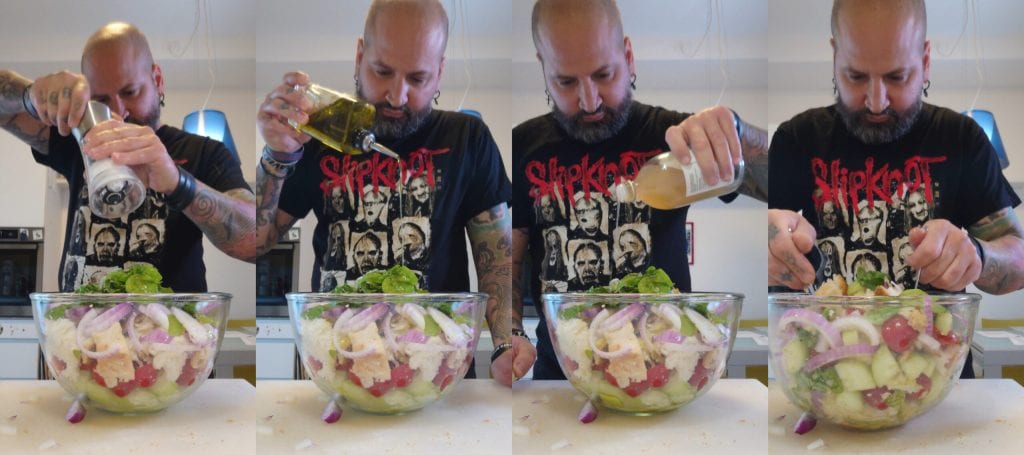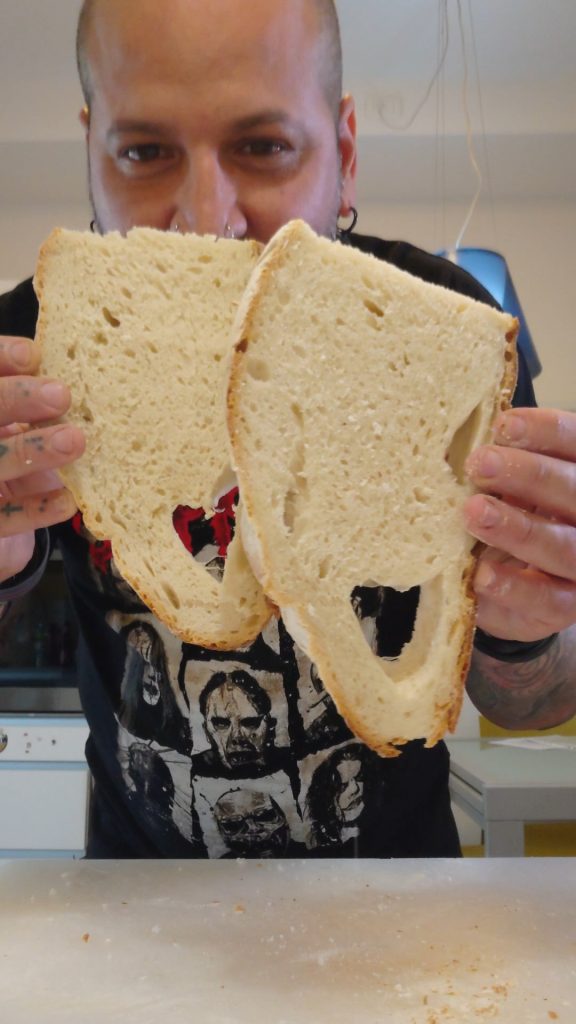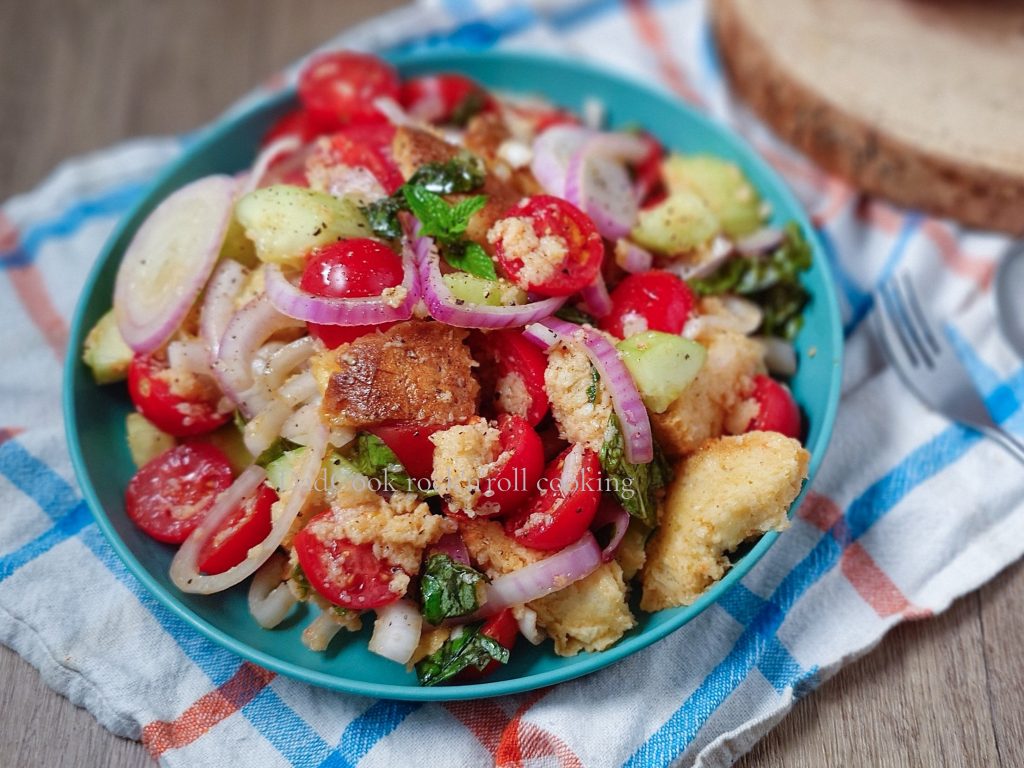Tuscan Panzanella: The Original Recipe for a Fresh and Genuine Summer Masterpiece.
Dreaming of a dish that encapsulates the essence of the Italian summer, capable of transforming simple ingredients into a true explosion of flavor?
Tuscan Panzanella is the answer you’re looking for!
This traditional recipe, a true symbol of Tuscany’s resourceful and humble cuisine, is the perfect way to give new life to stale bread, transforming it into an incredibly tasty, colorful, and refreshing salad.
The undisputed stars of this quintessential summer dish are ripe and juicy tomatoes, crunchy cucumbers, and red Tropea onion (or local vernina), which, together with soaked and well-squeezed bread, generously dressed with Tuscan extra virgin olive oil and fresh basil, create a balance of textures and flavors that is simply irresistible.
The true Panzanella is more than just a salad: it’s an experience, a dive into the rural tradition that celebrates seasonality and genuineness.
If you’re wondering how to make the original Tuscan Panzanella just like the grandmothers used to, you’re in the right place.
In this complete guide, we’ll reveal all the secrets and steps of the easy and authentic recipe to prepare a perfect Panzanella: from choosing the ingredients to soaking the bread, up to the essential resting time to blend all the flavors.
Get ready to discover why this humble dish has become an icon of Tuscan gastronomy and to bring a concentration of freshness and tradition to the table that will win over all your guests.
Follow our step-by-step recipe, and your homemade Panzanella will be a guaranteed success!

- Difficulty: Very easy
- Cost: Very economical
- Rest time: 10 Minutes
- Preparation time: 20 Minutes
- Portions: 4
- Cooking methods: No cooking
- Cuisine: Italian
- Energy 380.74 (Kcal)
- Carbohydrates 81.03 (g) of which sugars 8.56 (g)
- Proteins 9.73 (g)
- Fat 3.16 (g) of which saturated 0.41 (g)of which unsaturated 0.04 (g)
- Fibers 7.41 (g)
- Sodium 510.84 (mg)
Indicative values for a portion of 400 g processed in an automated way starting from the nutritional information available on the CREA* and FoodData Central** databases. It is not food and / or nutritional advice.
* CREATES Food and Nutrition Research Center: https://www.crea.gov.it/alimenti-e-nutrizione https://www.alimentinutrizione.it ** U.S. Department of Agriculture, Agricultural Research Service. FoodData Central, 2019. https://fdc.nal.usda.gov
Ingredients
- 14 oz stale bread (Tuscan Type)
- 1.1 lbs cherry tomatoes
- 1 cucumber
- 1 red Tropea onion
- 1 bunch basil
- 6 tbsps extra virgin olive oil
- 4 tbsps vinegar (To taste)
- 1 pinch salt
- 1 pinch black pepper
Tools
- 1 Ball tool Pyrex
- 1 Bowl Pyrex
Steps
Preparing the Tuscan Panzanella: The 4 Steps to a Summer Masterpiece
Prepare the Stale Tuscan Bread: The Crunchy and Soft Heart of Your Panzanella.
Start by taking your stale Tuscan bread, ideally a couple of days old.
Cut it into slices not too thin, about 0.5-1 inch, and then roughly break it apart with your hands or cut it into large cubes.
Place the bread in a large bowl and soak it with fresh water to which you have added a splash of white wine vinegar.
The goal is to soften it just right: the bread should absorb the liquids and become tender, but not mushy.
Some prefer to wet it quickly and squeeze it right away, others let it moisten more gradually, adding water little by little until it is well hydrated but still substantial.
Choose the method that ensures moist but not overly soft bread.

A Triumph of Vegetables and Bread: Assemble the Colorful Base of Your Panzanella.
Now focus on the vegetables, true stars of summer.
Carefully wash the ripe and firm tomatoes – ideally Florentine ribbed, San Marzano, or flavorful cherry tomatoes – and cut them into large pieces directly into the very large salad bowl you will use, collecting their precious juice as well.
Peel the cucumbers (or leave part of the peel if organic and very fresh), remove the ends, and slice them into rounds or cubes, adding them to the tomatoes.
Thinly slice a nice red Tropea onion; if you want to make it more delicate, you can have previously soaked it in cold water and a splash of vinegar for about twenty minutes, then drain it well and add to the other vegetables.
At this point, take the soaked and broken bread (gently squeezed if necessary to remove only the excess water) and add it directly to the bowl with the vegetables.
Only now, to complete this rich and colorful base, add plenty of fresh basil leaves, torn strictly by hand to release their intense aroma.

The Perfect Dressing: Enhance the Flavors of the True Tuscan Panzanella.
With the base of bread, vegetables, and basil ready in your salad bowl, it’s time to give the magic touch with the dressing.
Generously drizzle your authentic Tuscan Panzanella with high-quality Tuscan extra virgin olive oil – the Panzanella calls for it, don’t be stingy!
Continue with a few tablespoons of white wine vinegar (or red if you prefer a stronger flavor), season with fine salt, and for a lively touch, a grind of fresh black pepper, if desired.
Mix everything with great care but gently, using clean hands or two large spoons, ensuring that every piece of bread and vegetable is lovingly enveloped in the dressing and starts absorbing the delicious juices and aromas.

The Rest of the Panzanella!: The Wait that Enhances Every Flavor.
This is a crucial step, the secret to a textbook Panzanella: patience!
Cover the salad bowl and let the Panzanella rest for at least an hour (but two or three hours will make it even more sublime!) at room temperature, or in the fridge if the day is particularly hot (in this case, remember to take it out about twenty minutes before serving).
During this precious rest time, the flavors will blend harmoniously, the bread will perfectly absorb the dressing and the vegetable juices, and your Panzanella will reach its fullest expression of taste and fragrance.
Before triumphantly bringing it to the table, taste it one last time and, if necessary, adjust the salt or oil.
Plate your fresh and tasty Tuscan Panzanella and get ready to receive compliments: the tasting will be a real journey through the most authentic and beloved flavors of Tuscany!

Storage, Tips, and Variations:
Storage:
Tuscan Panzanella is best eaten on the same day, but can be stored in the refrigerator, well covered in an airtight container, for 1-2 days at most.
In fact, many believe it is even more flavorful the next day, as the flavors will have had more time to meld together.
Keep in mind that the bread’s texture may become slightly softer.
Freezing is not recommended.
Take it out of the fridge at least 20-30 minutes before serving again.Tips for Perfect Results:
Quality First: The secret to an unforgettable Panzanella lies in the quality of the ingredients. Use stale Tuscan bread (ideally “sciocco”, without salt), ripe and fragrant tomatoes, and excellent Tuscan extra virgin olive oil.
Bread, Balance is Everything: The bread should be soaked just right: moist and flavorful, but not a mush. Gently but firmly squeeze to remove excess water.
Sweetened Onion: If you prefer a less pungent flavor, soak the sliced red onion in cold water and a splash of vinegar for about 20-30 minutes before adding it.
Drain well.
The Importance of Rest: Don’t rush! Resting time is crucial: it allows the bread to absorb the dressing and the flavors to blend harmoniously.
Small Variations on the Theme (Respecting Tradition):
A Touch of Crunchiness: In some areas of Tuscany, it is traditional to add thinly sliced white celery stalks for a fresh and crunchy note.
Garden Aromas: You can add some pitted Taggiasca olives or desalted capers for a stronger flavor, or a pinch of dried oregano if desired, although the classic recipe favors the simplicity of basil.
The Right Vinegar: Experiment with different types of white wine vinegar or, for a more delicate note, with apple cider vinegar. The important thing is that it is of good quality.
Remember, the beauty of Panzanella lies in its simplicity and the freshness of seasonal ingredients!
Remember, the beauty of Panzanella lies in its simplicity and the freshness of seasonal ingredients!
FAQ (Questions and Answers)
Frequently Asked Questions (FAQ) about Tuscan Panzanella
What type of bread is absolutely essential for an authentic Tuscan Panzanella?
For the true Tuscan Panzanella, it is crucial to use stale Tuscan bread, the “sciocco” type (without salt), at least a couple of days old.
Its porous texture and ability to absorb liquids without falling apart are fundamental.
Avoid sandwich bread, soft rolls, or types of bread that are too fresh, as they would become mushy.
Do I need to squeeze the bread a lot after soaking it? Is there a trick?
Yes, the bread needs to be squeezed, but with the right delicacy.
After soaking it in water and vinegar, it should be pressed between your hands to remove excess water, otherwise, the Panzanella will be too watery.
The goal is moist and spongy bread, not soggy or completely dry.
It should not crumble too finely.
The raw onion tastes too strong for my liking, what can I do?
A classic trick to soften the red onion (preferably Tropea or Certaldo) is to slice it thinly and soak it in a bowl with cold water and a tablespoon of vinegar for about 20-30 minutes.
After soaking, drain it well and lightly dry it before adding it to the Panzanella. This process will make it sweeter, crunchier, and more digestible.
Can I prepare Panzanella well in advance?
How is it best stored?Absolutely yes!
Panzanella is one of those dishes that benefits from resting.
Making it at least 1-2 hours in advance allows the flavors to meld perfectly. You can easily make it in the morning for the evening.
It keeps well in the fridge, in an airtight container, for 1 or a maximum of 2 days.
Remember to take it out of the fridge about 20-30 minutes before serving it to enjoy it at its freshest.

